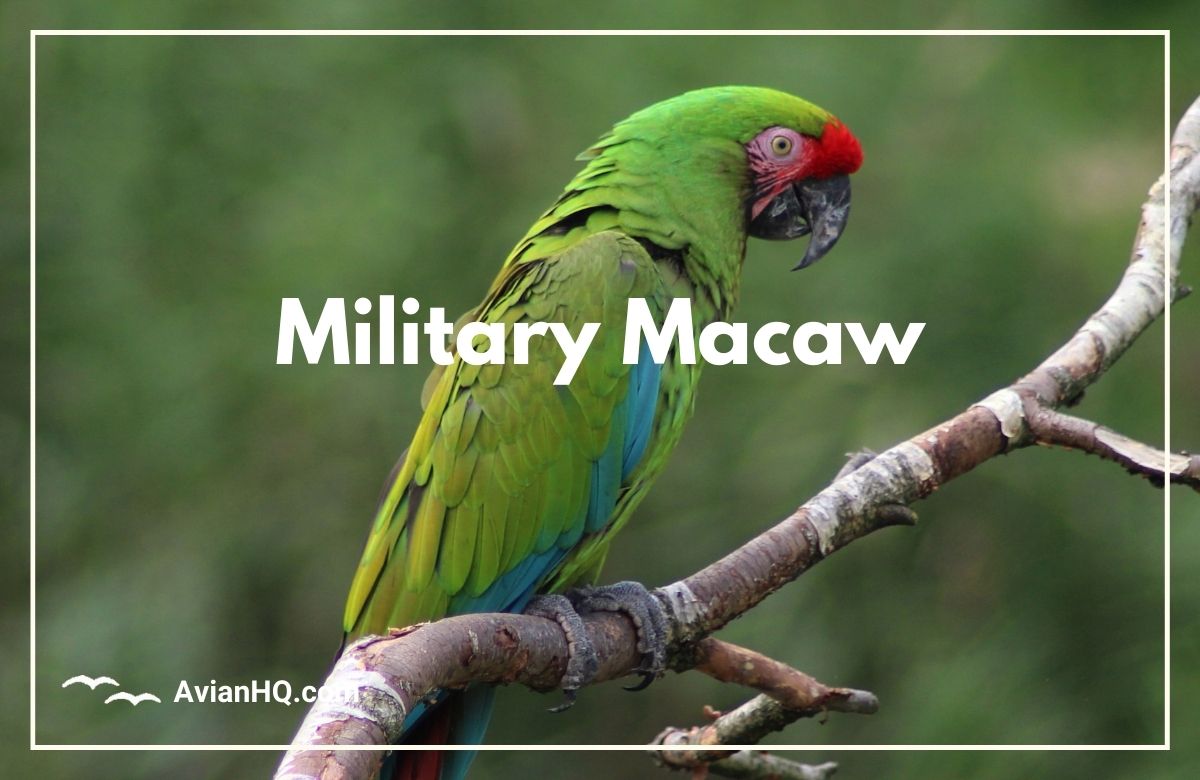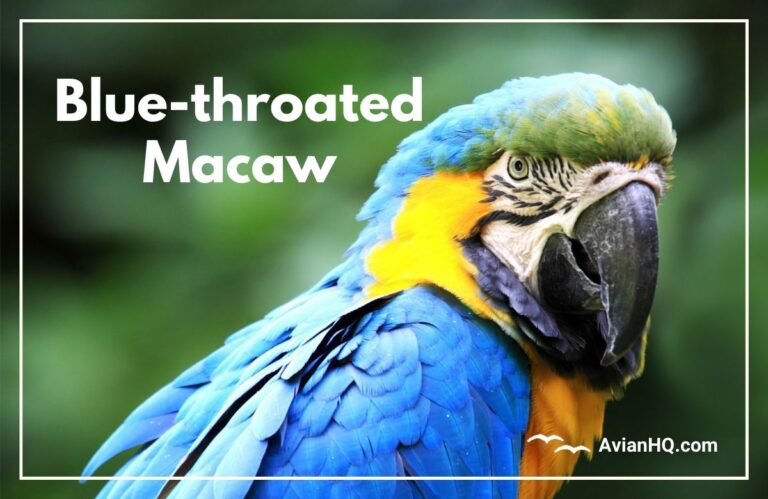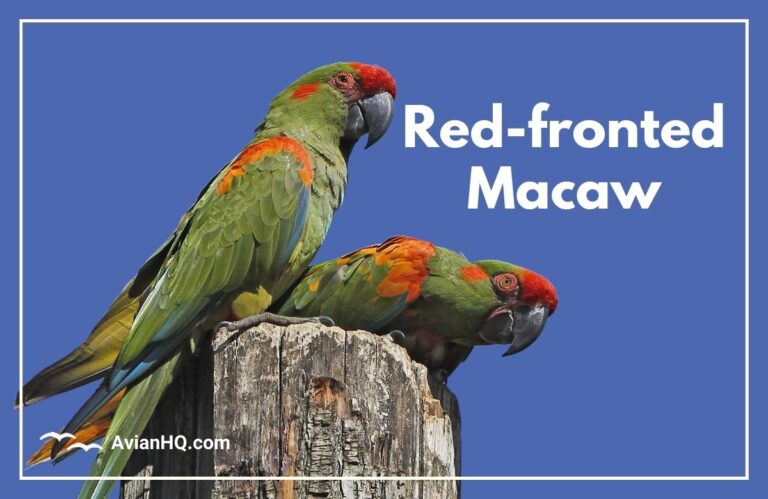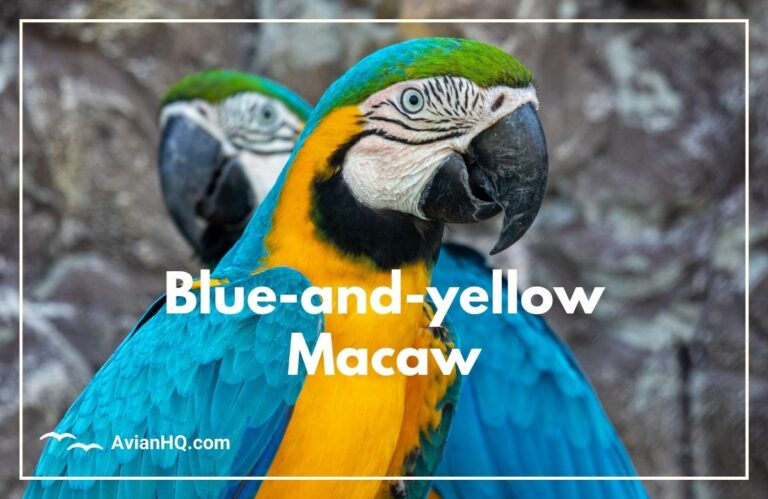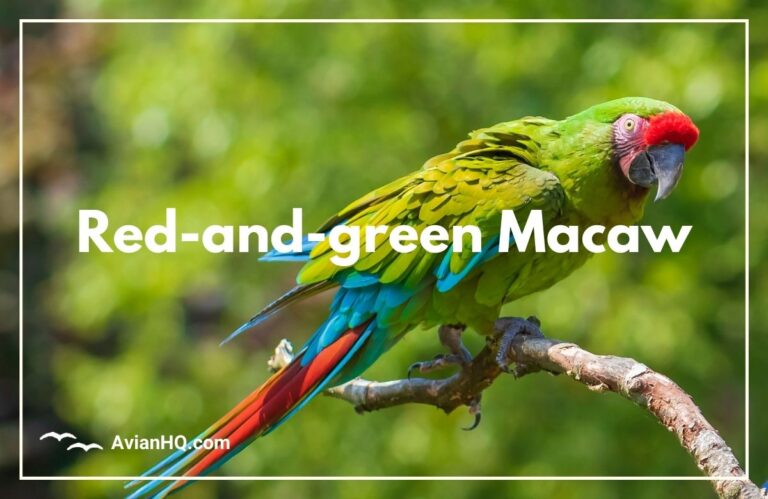Military Macaw (Ara militaris)
Have you ever seen a vibrant parrot with green feathers accented by bright red, blue, and yellow? If so, you may have spotted the Military Macaw, a visually striking tropical bird.
A Parrot Rich in History
The Military Macaw’s name gives a nod to its appearance, not its temperament. When spotted in flight, the parrot’s green coloration resembles a military uniform.
First described scientifically in 1766, Carl Linnaeus dubbed the bird Psittacus militaris. Today it resides in the Ara genus as Ara militaris.
“Military” stuck over the centuries, referring to the parrot’s resemblance to a soldier in dress uniform.
You’ll also hear it called the Military Parrot. No matter what you call it, this macaw holds distinction as one of the most colorful in the parrot family.
Where To See a Military Macaw
Spanning Mexico down through Argentina, Military Macaws inhabit tropical and subtropical forests from sea level up to 6,500 feet.
- In Mexico, they frequent arid woodlands and humid lowland areas
- In Colombia and Venezuela, they’re most common along rainforest edges
- Populations in Bolivia and Argentina stick to mountain foothills
Though rare, a small introduced group lives in Florida as well.
Military Macaws carved distinct niches across their native lands. From hot to cool climates and low to high elevations, they adapted to diverse settings!
Standing an impressive 27 to 37 inches (70 to 95 cm) tall with a wingspan reaching 43 inches (110 cm), few sights impress more than a Military Macaw taking flight! Their large size and loud squawks announce their presence wherever they roam.
History and Taxonomy
The journey of classifying the Military Macaw traces back centuries. Long part of indigenous lore, European naturalists first described the vivid species in official records in the 1700s.
Spotted by Early Scientists
Swedish naturalist Carl Linnaeus introduced the world to the Military Macaw in 1758. Examining a colorful parrot specimen, Linnaeus deemed it a new discovery.
He grouped the bird into the Psittacus genus alongside all other parrots known at the time. Linnaeus gave it the name Psittacus militaris, drawing from its uniform-like green plumage.
For over 200 years, the macaw kept its original naming and classification until scientists reorganized parrot genera later on.
Reorganization Into the Ara Genus
In the late 1700s, French naturalist Bernard Lacépède proposed a new parrot genus – Ara. His suggestion stemmed from observations of unique physical and behavioral traits that set certain parrots apart.
It took many decades, but the scientific world eventually shifted the Military Macaw into Lacépède’s Ara genus based on its attributes. Today, scientists recognize around 10 species within the Ara genus.
The Military Macaw’s scientific name morphed to Ara militaris, though its unique “military” inspired epithet remains intact.
Recognizing Three Distinct Subspecies
Over the centuries, ornithologists identified unique Military Macaw populations isolated geographically across Central and South America. Modern science delineates three distinct subspecies based on size, color, and habitat:
- Mexican Military Macaw (A. m. mexicanus): The largest subspecies, up to 37 inches in height. Lives in Mexico’s arid forests.
- South American Military Macaw (A. m. militaris): The nominate subspecies and most widespread, up to 33 inches tall. Occupies forests from Colombia to Peru and Bolivia.
- Bolivian Military Macaw (A. m. bolivianus): Slightly smaller at up to 31 inches in height. Confined to Bolivia and northwest Argentina.
Unique origins shaped equally unique macaws now united as a brilliant species!
Physical Appearance
What first captures attention in the Military Macaw is a stunning mosaic of vibrant colors and striking features. Commanding a powerful presence, the large macaw’s appearance leaves a lasting impression – truly, looks befitting an avian soldier!
Size & Mass of a Large Parrot
One of the world’s largest parrot species, few dimensions of the Military Macaw are small. On average they reach up to:
- Height: 27-33 inches (70-85 centimeters)
- Wingspan: 43 inches (99-110 centimeters)
- Weight: Approximately 2 pounds (900 grams)
The Military Macaw’s substantial size is one of many adaptations that aid its survival in the wild.
A Rainbow of Color
Feathers of vibrant green, red, blue, yellow and white endow the Military Macaw with spectacular visual appeal.
- Head: White facial skin lined with black “scales”; bright red forehead patch.
- Body: Mostly green overlapping feathers resembling a uniform.
- Wings: Blue flight feathers; yellow and green secondary coverts.
- Tail: Long, mostly red and green with dark blue tip.
The green body plumage dominates, explaining the macaw’s alternate “Great Green Macaw” label. However, the red, blue, and yellow accents set it apart from the Great Green.
Military Macaws almost appear dressed in their best attire, adorned like soldiers donning full regalia!
Intricate Markings & Features
Beyond sheer color spectacle, military macaws showcase a collection of arresting physical characteristics:
- Bill: Large, solid greyish-black bill ideal for cracking nuts and seeds.
- Eyes: Pale yellow irises encircle black pupils.
- Bare facial skin: Mix of featherless white and black skin, a trait of macaws.
Military Macaw subspecies show minor variations in size, bill shade, or exact plumage hues. But all wear this species’ signature motif – green coloration marked by bright red, blue and yellow touches.
Habitat and Distribution
The Military Macaw inhabits a range as impressive as its coloration, spanning diverse lands from Mexico down to Argentina. Populations carved niches in various elevations and environments across Central and South America.
Wide Native Distribution
At the peak of its territory, the Military Macaw could be found in:
- Mexico
- Colombia
- Venezuela
- Ecuador
- Peru
- Bolivia
- Argentina
Its range spreads over 3,000 miles from north to south! Within that swath, the macaws concentrate in:
- Tropical forests: rainforests, evergreen woodlands, riparian corridors
- Subtropical areas: dry forests, wooded foothills
They typically stick to lower mountain slopes, but may range anywhere between sea level and 6,500 feet elevation. The three subspecies concentrate in different countries.
Introduced Florida Population
A small group of military macaws now lives outside its endemic range, having been deliberately or accidentally released in Florida. Concentrated near Miami, it’s unknown if those individuals are sustaining a breeding population.
While rare in the USA, military macaws occur over a vast belt of Latin America in diverse habitat from lush jungles to arid subtropical woodlands.
This adaptability let the macaw carve its wide niche across changing terrain and climates in the Americas.
Diet and Feeding
The Military Macaw follows a varied, nutrition-rich diet ideal for an energetic, social species on the move. They forage a range of plant foods, with a few key dietary strategies upping their nutrient intake even further.
An Omnivorous Diet
The macaws are omnivores, feeding on diverse fare from the plant kingdom:
- Nuts and seeds
- Fruits
- Berries
- Leaf shoots
This varies by food availability and region. But a mix of proteins, carbohydrates and beneficial plant compounds nourishes the active macaws.
Favorite foods: palm nuts, Brazil nuts, walnuts; native fruits like anon, papaya, passion fruit and figs.
Special Feeding Behaviors
Military macaws have a couple unique dietary adaptations:
- Clay licks: Wild groups gather at exposed river clay deposits to supplement their diet with vital minerals like sodium. The clay also neutralizes toxins and aids digestion.
- Flock feeding: Foraging in noisy groups as large as 10-50 birds, they cover more ground to take advantage of spotty food sources. Bright light signals dawn and dusk feeding runs.
Clever feeding strategies help military macaws prosper across the Americas, fueled by their diverse, nutrient-dense omnivorous diet!
The macaws remain adaptable in both habitat niches and dietary habits. This serves them well across varied tropical lands.
Breeding and Reproduction
Military macaws go through intricate courtship and mating behaviors leading to tight pair bonds and sustained family units. These parrots mate for life! Seasonal patterns shape their breeding ecology across their endemic lands.
Pairing Up for Life
Military macaws practice complex mating rituals compared to other birds:
- Court for several seasons before finally mating
- Males feed female potential mates as part of courtship
- Groom each other extensively preening feathers (allopreening)
- Regurgitate food to share with their partner
Once paired, the monogamous bond normally endures for the rest of the macaw’s life – up to 60 years!
Season Cycles Guide Breeding
As with most macaws, factors like seasonal food abundance determine Military Macaw breeding cycles:
- Courtship: March through May
- Mating: May through July
- Nesting: August through January
On average, peak egg laying and chick rearing aligns with late summer rainy periods.
Raising Demanding Chicks
Successful breeding requires immense energy investment:
- Only produce 2-3 eggs per clutch
- Incubation lasts 26 days
- Chicks fledge at 13 weeks, completely independent around 6 months
- Maturity finally reached between ages 2-4 years!
Complex behaviors support enduring pair bonds and slow chick development – but military macaws harness seasonal rhythms for breeding success.
Their tight breeding pairs likely aid the survival of vulnerable chicks needing extensive parental care over months to mature.
Behavior and Ecology
Military macaws lead active, social lives typical of highly intelligent parrot species. Complex behaviors shape their daily routines across their forested habitats.
Highly Social Across All Activities
More than many solitary bird species, military macaws integrate flock activities into nearly all daily routines:
- Roost in groups up to 50 on cliffsides or large trees
- Forage nuts, fruits, and seeds in noisy feeding groups
- Gather at traditional clay licks alongside other macaws and parrots
- Nest in clustered tree colonies for safety and mating access
Constant vocalizations help maintain contact and coordinate movements.
Dawn and Dusk: Prime Activity Times
In sync with most rainforest fauna, the macaws schedule peaks in activity predictably at:
- Dawn = First morning light signals the whole colony to leave the roost, soar over the forest, and commence feeding
- Dusk = As light fades, evening flight patterns lead back to gathering sites for overnight communal rests
These rhythms align with rainforest food availability.
Vigorous activity sustains military macaws’ high energy levels and social ties across their habitat range.
Frequent activity and temporal routines ultimately support breeding success. Their behaviors maintain a strong, interconnected flock.
Conservation Status
While still widespread across parts of Latin America, multiple threats place Military Macaw populations at rising risk. Habitat loss and trapping pressures whittle away breeding pairs critical to future generations.
Vulnerable to Extinction
The major global conservation authority – the International Union for Conservation of Nature (IUCN) – declares the Military Macaw “Vulnerable” on its Red List of Threatened Species.
- This means the species faces high risk of extinction in the medium-term future if threats continue unabated.
Driving the alarming assessment is a population estimated to be rapidly dwindling across their range:
- 2000-7000 mature adult Military Macaws left in the wild
- Many local extinctions reported already
Multiplying Threats
What’s afflicting the Military Macaw?
- Habitat loss: Deforestation for farms and grazing continues fragmenting its rainforest niche.
- Illegal trapping: Live capture for the pet trade persists despite a ban on international wild bird trafficking.
- Climate change: Could begin altering its specialized forest habitats long-term via weather shifts.
Targeted conservation initiatives are still attempting to reverse the Military Macaw’s slide before populations dip too low. But time is running short for the brilliant macaw named after soldiers but facing formidable threats of its own.
Without intervention, the “vulnerable” tag risks upgrading to “endangered” – or worse.
Cultural Significance
Beyond scientists and bird enthusiasts, the Military Macaw holds special meaning for many indigenous peoples across its Latin American range. Vivid appearances and loud voices wove them into the cultural fabric.
Enduring Native Lore
Well before European naturalists took note, vibrant green macaws captivated local cultures:
- Mythology appearances as colorful messengers between spiritual and earthly realms
- Association with Sun and fertility due to radiant plumage hues
- Symbol of potency and sacred power for tribal shamans and warriors
These themes persisted for centuries as native groups observed the macaw’s ecology.
Modern Associations
Today the Military Macaw remains intertwined with regional cultures:
- National bird of Honduras, appearing on currency and postal stamps
- Green and red macaw feathers used in traditional dances and coming-of-age ceremonies
- Bird name origins in indigenous languages – “guacamaya” traces back to Nahuatl term “quauhcalli”
- Ecotourism interest in birding hotspots to see wild macaws
This enduring cultural legacy testifies to the Military Macaw’s longstanding ties to Latin American peoples. Yet another reason conservationists aim to preserve its fragile populations.
Without intervention, more than a colorful rainforest bird could fade away, but spiritual and cultural links centuries old.
Conclusion
The vibrant green Military Macaw has long impressed with bright colors and loud calls echoing across Latin America’s forests. Yet loss of habitat and trapping for pets whittle away one of the world’s largest parrots.
As a species that mates for life and relies on disappearing rainforest resources to breed, Military Macaws cling precariously to an existence that evolved over millennia. Even the isolated introduced group in Florida likely couldn’t sustain the species.
Conservationists maintain hope – and indeed have documented small successes via captive breeding and forest preservation. But the situation remains tenuous at best long-term for Ara militaris without continued intervention at a wider scale.
Loss of the Military Macaw would reverberate deeper than silent forests. Indigenous cultures revere the macaw as much more than a colorful bird. Its existence threads back centuries as a spiritual and ceremonial icon intertwined in native lore.
Perhaps most critically, the Military Macaw represents another struggling rainforest inhabitant sounding alarms about extensive deforestation threatening entire ecosystems sheltering rare wildlife. More than an individual species is at stake.
Can conservation efforts shift the tide for this vulnerable parrot and the lands it inhabits? Providing protected habitats and limiting trafficking will determine whether future generations still experience one of nature’s most spectacular avian gems lighting up Americas’ skies.

